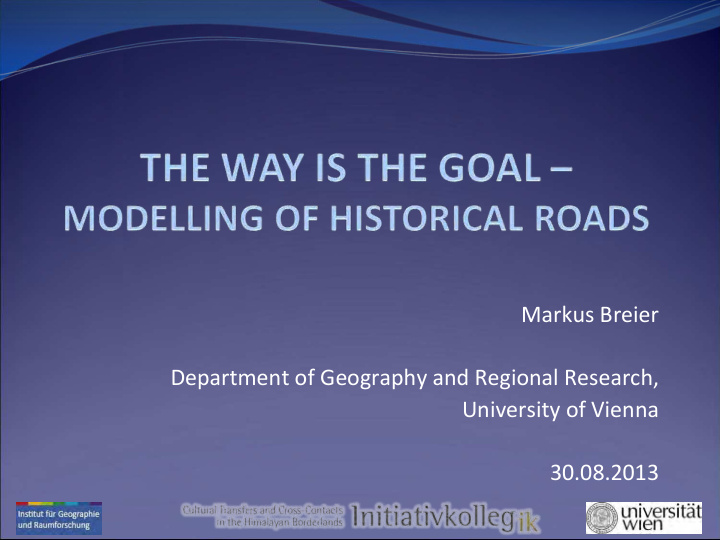



Markus Breier Department of Geography and Regional Research, University of Vienna 30.08.2013
20/09/2013 Markus Breier 2
MODELLING HISTORICAL ROADS Where could the historical road have been? 20/09/2013 Markus Breier 3
METHOD: LEAST COST PATHS Algorithms to find most cost ‐ efficient path from start point to end point across a surface 20/09/2013 Markus Breier 4
CASE STUDY I: BYZANTINE ROAD 20/09/2013 Markus Breier 5
THE ROAD IN THE STRUMICA VALLEY (12 th – 14 th Late Byzantine Era Century) Written sources (documents) 1152: basilikos dromos (Greek): „emperor‘s road“ 1336: veliki put (Old Slavonic): „big road“ 1371: basilike hodos (Greek): „emperor‘s road“ 1375/1376: veliki carski put (Old Slavonic): „the big road of the emperor” Connection between Roman roads Via egnatia Via militaris (Via diagonalis) 20/09/2013 Markus Breier 6
DATA SITUATION Historical geodata hardly available River regulation Confidential data 20/09/2013 Markus Breier 7
INCLUDED COST FACTORS Physical Landscape Rivers Used data: Vector Map level 0, adjusted to DHM Modelled as barriers Relief Used data: SRTM (90m resolution) ASTERDEM (30m resolution) Height above sea level Effective slope 20/09/2013 Markus Breier 8
20/09/2013 Markus Breier 9
CASE STUDY II Historical travel routes in the Western Himalayas Rinchen Zangpo (956 – 1055 CE) Tibetan monk, translator Travelled from Tibet to Kashmir and back Brought with him artisans Started the “later propagation of Buddhism in Tibet” No exact travel route is known 20/09/2013 Markus Breier 10
WESTERN HIMALAYAS 20/09/2013 Markus Breier 11
PRELIMINARY CALCULATIONS 20/09/2013 Markus Breier 12
MAIN ISSUES Integration of social landscape Trade routes, trade centers, sacred sites (temples, monasteries,..) Data situation Historical geodata Evaluation Visualization 20/09/2013 Markus Breier 13
CONCLUSION AND OUTLOOK Promising method Only approximation Framework for other cases Advocates the use of GIS and cartography in historical research 20/09/2013 Markus Breier 14
ACKNOWLEDGEMENTS Initiativkolleg “Cultural Transfers and Cross ‐ Contacts in the Himalayan Borderlands” (University of Vienna) Austrian Academy of Sciences, Institute for Medieval Research, Division of Byzantine Research, especially Dr. Mihailo Popovi ć University of Vienna, Department of Geography and Regional Research The Center for Interdisciplinary Research and Documentation of Inner and South Asian Cultural History (CIRDIS) markus.breier@univie.ac.at 20/09/2013 Markus Breier 15
Recommend
More recommend